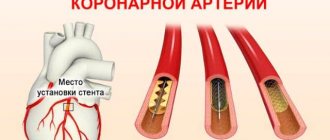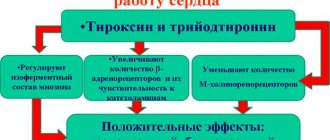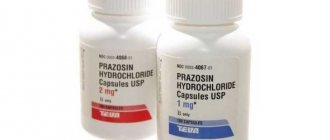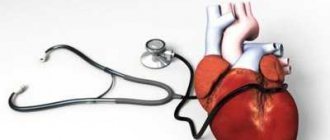© Author: Sazykina Oksana Yuryevna, cardiologist, especially for SosudInfo.ru (about the authors)
Heart transplantology as a separate field of medicine arose at the intersection of cardiology and immunology - a science that deals with human immunity and is of decisive importance in matters of engraftment and rejection of the transplant (“planted” biomaterial).
The first research conducted in the field of heart transplantation began in the fifties of the last century. Successful operations were performed by doctors in South Africa and the USA in the 80s. The first heart transplant in the USSR was performed in 1988 by V.I. Shumakov. Due to the fact that the immunological basis of graft-host reactions was previously insufficiently studied, the quality of life and its duration after surgery did not correspond to the desired results, and the prognosis was uncertain.
At the present stage, the level of knowledge allows such operations to be performed with minimal risk of complications and with sufficient life expectancy after heart transplantation (slightly less than half of patients live more than 10 years after surgery).
In some cases, even repeated transplants are possible, for example, one of the richest people in the world according to Forbes magazine, David Rockefeller, at the age of 99, underwent his sixth heart transplant.
Indications for surgery
Heart transplant surgery is one of the least common operations in cardiac surgery. This is due not only to large financial costs, but also to the following nuances:
- Limited number of donors - persons with confirmed brain death, but with a healthy heart,
- The long period of time required to select a donor according to waiting lists, especially for heart transplant surgery for a child,
- Problems of an ethical nature, including from a religious point of view (in particular, according to Christian beliefs, a person is considered alive as long as his heart beats),
- Problems of postoperative management of patients associated with the duration and high cost of the rehabilitation period,
- Short period of storage of the donor heart (up to six hours).
However, despite the problems of this kind, operations, although rare, are still carried out, and very successfully.
The main indication for which a heart transplant is needed is the terminal (final) stage of chronic heart failure (CHF), or functional class 3 - 4, which cannot be treated with medications, with a survival prognosis for this condition of less than a year.
It is the symptoms characteristic of the last stage (pronounced limitation of activity, significant swelling of the limbs or the whole body, the appearance of shortness of breath at rest) that, if conservative therapy is ineffective, may require a donor heart transplant.
Such severe heart failure can develop due to the following diseases:
hypertrophic cardiomyopathy is the main indication for heart transplantation.
Cardiomyopathy (CMP) is a structural restructuring of myocardial fibers, its replacement with scar tissue, leading to impaired contraction and relaxation of the heart muscle, more often the development of CHF is provoked by dilated and ischemic cardiomyopathy,- Congenital and acquired inoperable heart defects,
- Heart tumors
- Uncontrollable angina and severe cardiac arrhythmias that are not amenable to drug therapy and lead to severe impairment of cardiac function.
In addition to the above indications, data from objective research methods (ultrasound of the heart and pulmonary artery catheterization) are taken into account:
- Left ventricular ejection fraction less than 20%,
- No severe pulmonary hypertension.
Certain conditions must also be met when planning an operation:
- The age of the recipient (the person to whom the heart will be transplanted) is less than 65 years old,
- The patient's diligence and desire to follow a further strict treatment and observation plan.
What determines the cost of coronary bypass surgery?
The operation, although relatively common, is far from simple. There are a huge number of factors that influence the invoice that will be issued.
- Technology - if a mini-access is used, then the cost of the operation itself increases significantly, but the rehabilitation period will be much shorter, because in this technology there is no dissection of the chest.
- Difficulty - before any surgical intervention, and indeed before making a diagnosis, it is customary to conduct an examination to understand how advanced everything is, how potentially complex the operation will be, whether there are great risks, whether there is a need for such a serious intervention at all. And the worse the situation, the more expensive the operation will cost.
- The patient’s status is in Russia; if the patient is a foreigner, then in most cases coronary bypass surgery will cost him one and a half times more. Discounts are usually provided for healthcare employees.
- Qualification of the surgeon - the higher the category of the operating doctor, the more expensive his services will cost.
If you suddenly need such a procedure, you need to be prepared to pay twice or three times the originally stated price.
What should a donor's heart look like?
A person in a coma with confirmed brain death, whose cardiac activity is supported by equipment in the intensive care unit, can become a heart donor. As a rule, such severe patients are observed in the hospital after road accidents or strokes. That is, in fact, the person is already dead, since the artificial lung ventilation device breathes for him, and the heart works with the help of medications. But if such a heart is implanted into another person, it will work autonomously in the new organism. In order to remove the heart from the body of such a patient, the consent of relatives or the patient himself, written during his lifetime, is required. If there are no relatives, or the patient remains unidentified, his heart can be taken away without official documents.
Donor heart ready for transplantation
After a commission of several people, including the chief physician of the clinic where the donor is located, fills out the necessary documents, a doctor from the transplant center arrives, always with an assisting nurse. Next, an operation is performed to collect a donor heart, which is placed in a container with a cardioplegic solution and transported to the center.
Below are the criteria for selecting donor hearts:
- The absence of cardiac pathology, confirmed by the results of ECG, ultrasound of the heart and coronary angiography (CAG, performed for donors over 45-50 years old),
- Absence of malignant tumors,
- Absence of HIV infection, viral hepatitis (B, C),
- Compatibility of donor and recipient blood groups according to the ABO system,
- Approximate sizes of the donor and recipient hearts, estimated according to the results of cardiac ultrasound.
Diagnosis of heart valve defects
Often, patients learn about problems with heart valves after a full, adequate examination by a doctor, who, during auscultation, identified a heart murmur, after which the patient is prescribed a number of tests that have different diagnostic value:
- transesophageal echocardiography (more complex and more expensive study);
- ECG;
- transthoracic echocardiography (ultrasound of the heart) is the most informative, common and inexpensive way to diagnose pathology of the heart valve apparatus;
- aortoventriculography;
- chest x-ray;
- multislice computed tomography with contrast.
At the initial stage of the disease, the patient may be prescribed medications that help the heart compensate for the excessive load due to valve disease. The selection of optimal therapy in this case should be carried out by an experienced cardiologist. However, heart valve disease is a problem that over time may require surgery to repair or replace the damaged valve.
Indications for heart valve replacement surgery:
- progressive heart failure;
- hemodynamically significant valve lesions;
- ineffectiveness of drug therapy;
- risk of severe complications.
Surgical treatment: heart valve replacement
In recent years, significant progress has been made in the surgical treatment of heart valves. Improvements in technology (including artificial blood circulation machines), the development of uniform standards and protocols for both preoperative examination and the course of the operation have made it possible to reduce the risks of perioperative complications, making the operation on the heart valve apparatus safer than refusing surgery and trying to live with valve dysfunction.
There are basically two types of heart valve surgery:
- prosthetics with artificial or biological prosthesis,
- reconstructive interventions.
It is quite natural that a person’s own valve, after successful reconstruction, functions better than an artificial prosthesis.
Reconstruction of the valve apparatus
The purpose of valve repair is to eliminate the cause of its dysfunction. One of the options for plastic surgery of the mitral valve in case of mitral insufficiency is the removal of part of its posterior leaflet with subsequent annuloplasty or only annuloplasty (strengthening the fibrous ring of the valve using special support rings or reducing the diameter of the fibrous ring using special sutures - plastic according to De Vega, according to Batista, according to Alfieri).
In case of prolapse of the anterior leaflet of the mitral valve, it is possible to perform prosthetic replacement of the anterior leaflet chords, which normally ensure tight closure of the mitral valve. In case of aortic insufficiency, it is possible to perform an operation to normalize the closure of the valve leaflets - plastic according to El-Khoury. In case of valvular stenosis and the absence of calcification of the leaflets and fibrosis of the leaflets and subvalvular structures, it is possible to perform an open commissurotomy (separation of the areas of fusion of the valve leaflets).
How long should I wait for surgery?
In order for a patient to receive a new heart, a waiting list must be created at the transplant center. Such centers cooperate with medical institutions where possible donors can potentially be observed - trauma hospitals, neurological hospitals, etc. Periodically, the center sends a request to hospitals about the availability of a possible heart donor, and then compares those in need of a transplant and available donors according to the above selection criteria. The patient receives a referral to the transplant center from the attending physician - a cardiologist and/or a cardiac surgeon.
After a waiting list has been created, a significant amount of time may pass, and if a suitable donor is not found, the patient may die of heart failure without receiving surgery. If a donor is found, the operation will be carried out in the coming weeks.
Due to the fact that the main indication for CHF is the patient’s predicted survival of less than one year, it is necessary to look for a donor during these critical periods.
Indications for surgery
Indications for heart transplantation:
- chronic heart failure stages 3 – 4 according to the New York classification;
- IHD at the stage of dystrophic changes;
- dilated cardiomyopathy accompanied by systolic dysfunction of the heart;
- severe arrhythmias that threaten the patient’s life;
- congenital heart abnormalities that cannot be corrected by plastic surgery;
- unstable angina (progressive);
- signs of severe stenosis of the coronary arteries;
- benign neoplasms of the heart.
Heart transplantation is a complex and expensive operation, so it is performed only in cases where conservative treatment does not bring the desired result.
Cost of heart transplant surgery
A law has been passed around the world banning organ trafficking; only cadaveric and related transplants are allowed. Therefore, the heart itself is given to the patient free of charge. Only the cost of the operation, drug support before and after the transplant, as well as the cost of the rehabilitation period are paid. In general, amounts vary and range from 70 to 500 thousand dollars, with an average of about 250 thousand dollars. In Russia, it is possible to provide the population with free high-tech types of care and pay for operations under quotas (in the compulsory medical insurance system), but in any case, the exact cost and the possibility of a free operation should be clarified with the attending physician - a transplantologist.
In Russia, there is only one single coordination center that selects donors, operating throughout Moscow and the Moscow region. Direct heart transplantation is performed in:
- Federal Scientific Center for Transplantology and Artificial Organs named after. V. I. Shumakov in Moscow, (FSBI "FNTSTIO named after V. I. Shumakov"),
- Research Institute of Circulatory Pathology named after. E. N. Meshalkina in Novosibirsk,
- FSBI North-Western Federal Medical Research Center named after. V. A. Almazov" in St. Petersburg.
Due to the fact that in our country the legislative and legal principles of organ donation have not been fully developed, heart transplant operations are rarely performed, for example, in 2014 only 200 operations were performed, while in the USA about 28 thousand transplant operations were performed . For the same reason (the ban on organ removal from patients under 18 years of age), children in need of heart transplants required expensive treatment abroad (Italy and India). But in May 2015, a document was adopted on the procedure for ascertaining brain death in persons over 1 year of age, which makes it possible to further develop the legislative framework in the field of child donation.
Contraindications for surgery
The operation may be contraindicated in the following cases:
- Severe pulmonary hypertension (high pressure in the pulmonary artery),
- Severe diabetes mellitus with damage to blood vessels, kidneys, retina,
- HIV infection, active tuberculosis process,
- Acute infectious diseases,
- Severe renal and liver failure,
- Systemic autoimmune diseases (systemic lupus erythematosus, rheumatoid arthritis, etc.),
- Severe chronic obstructive pulmonary disease,
- Alcohol or drug addiction,
- Oncological diseases,
- Mental illnesses in the acute stage.
Contraindications for heart transplantation
The main contraindications to heart transplantation are:
- malignant diseases regardless of location;
- alcohol abuse, drug addiction, smoking;
- diabetes;
- obesity 3 – 4 degrees;
- autoimmune inflammatory diseases;
- severe pulmonary hypertension;
- HIV, viral hepatitis B and C, tuberculosis;
- systemic inflammatory diseases of connective tissue;
- serious disturbances in the functioning of the liver and kidneys;
- serious mental illness;
- recipient's refusal to undergo surgery.
Previously, a contraindication to heart transplantation was the age of the recipient over 65 years, but now the issue of transplantation in such patients is decided individually.
Preparing for surgery
When a patient is referred to a transplant center and the decision is made to place him on the waiting list for a heart transplant, he is assigned an evaluation plan. Necessary tests include:
- Fluorography or x-ray of the chest organs,
- Blood tests for markers of HIV infection, viral hepatitis, syphilis,
- Clinical blood test, determination of coagulation system and blood group,
- General urine analysis,
- Ultrasound of the heart, ECG, if necessary - CAG,
- Examination by a cardiac surgeon,
- Examinations by an ENT doctor and dentist (to exclude foci of chronic infections in the nasopharynx and mouth),
- Examination by a gynecologist or urologist (for women and men, respectively).
In order to be admitted to the transplant center for surgery if a donor is found, the patient must always have originals and copies of the following documents on hand:
- Passport, medical policy, SNILS,
- An extract from the sending institution with the results of the examination,
- Referral from a medical institution at the patient’s place of permanent residence.
Heart transplant surgery
The first stage of heart transplantation is median sternotomy. It involves cutting and dividing the sternum. The incision is made in layers - skin and subcutaneous tissue, muscles, bone structures. Once surgical access is secured, the surgeon opens the pericardium and secures it to the chest muscles.
The next stage of heart transplantation is the inclusion of artificial circulation.
After the patient is placed on a heart-lung machine, the surgeon begins to remove the heart. Clamps are applied to large vessels and the pericardium. The aorta, pulmonary artery, both atria and the interatrial septum are crossed. The patient is left with a part of the heart containing the openings of the vena cava, pulmonary veins, and sinus node.
The next stage of heart transplantation is the actual transplantation of the donor organ. The prepared heart is fixed in the surgical wound, correctly oriented, the edges are brought together and connected with a continuous wrapping suture, which is applied in two rows. After suturing, the surgeon checks the integrity of the wall by examining the transplanted heart.
The integrity of large vessels is also restored using a continuous suture. First, the pulmonary artery is connected, then the ascending aorta. After applying the suture, the clamps are removed from the vessels, the catheters are removed from the vena cava, and artificial circulation is turned off.
The surgical wound is sutured in layers using modern suture material. If necessary, drains are inserted into the chest. At this point, the heart transplantation can be considered complete.
How is the operation performed?
Heart transplantation begins with removing the organ from the donor’s body and placing it in a cardioplegic solution for a period of no longer than 4-6 hours. At this time, preoperative preparation of the recipient is underway (administration of sedative and analgesic drugs - premedication). Next, in an operating room under general anesthesia, an incision is made into the recipient's anterior chest wall, large vessels are connected to a cardiopulmonary bypass machine (ACB), which performs the functions of an “artificial heart” during the operation.
After this, the right and left ventricles of the heart are cut off, while the atria are preserved. While maintaining the own atria, the sinus node remains active, setting the rhythm of heart contractions and being the pacemaker.
After the donor's atria have been sutured to the recipient's atria, a temporary pacemaker is installed to ensure adequate heart contractions after surgery. The chest is sutured and an aseptic bandage is applied. The operation takes several hours, sometimes no more than six.
The next stage of heart transplantation is immunosuppressive and cardiotonic (supporting cardiac activity) therapy. Immune suppression (mainly with the help of cyclosporine) is necessary to prevent transplant rejection reactions and improve its engraftment.
Recipient heart removal and transplantation scheme:
Video: progress of heart replacement surgery (18+)
Complications
Complications in the early postoperative period include bleeding from the surgical wound and infectious complications. The first can be quite successfully treated by reopening the wound and suturing the source of bleeding. Prevention of infectious (bacterial, fungal and viral) complications is the prescription of antibiotics and adequate immunosuppression regimens.
In the long-term postoperative period, the development of transplant rejection and dysfunction of the coronary arteries with the development of myocardial ischemia of the donor heart is possible.
Forecast
The prognosis after surgery is favorable - more than 90% of patients survive the first year safely, about 60% survive the first five years, and slightly less than half of those operated on (45%) live with a donor heart for more than 10 years.
How to do a heart transplant
The heart replacement procedure includes two stages:
- Preparation for surgery.
- The transplant operation itself.
The preparatory stage consists of a thorough examination of the patient’s body to timely identify contraindications for transplantation.
What does preparation for cardiac transplantation include?
During preparation for a heart transplant, the following diagnostic procedures are performed:
- Determination of blood parameters (group, Rh factor, coagulability).
- Blood test for the presence of hepatitis and immunodeficiency viruses.
- Screening for cancer, consisting of a mammogram and smear and cervical sampling for women, and a prostate specific antigen blood test for men.
- Examination for infection with herpes viruses.
Herpes viruses, such as cytomegalovirus, herpes virus and Epstein-Barr virus, can be activated during artificial immune suppression required after transplantation and cause dangerous diseases, including general damage to the body.
In addition to examining the general condition of the body, the heart and adjacent blood vessels are examined. If necessary, bypass surgery or stenting is performed. In addition, the patient must have his lungs checked using X-rays, as well as his external respiratory function.
The preparatory stage also includes medical procedures aimed at relieving existing heart diseases. Therapy includes the use of beta blockers, cardiac glycosides, diuretics, etc.
An extremely important part of preparation for surgery is immunological examination of tissues in accordance with the HLA system. Based on the results of this testing, a suitable donor heart will be selected.
Heart replacement surgery
A person under the age of sixty-five whose life was tragically cut short as a result of an accident, such as a car accident, can become a heart donor for a transplant. The main problem during transplantation is the timely delivery of a donor organ, since the maximum viability of a heart removed from a corpse is six hours from the moment of death. It is advisable to transplant the heart when no more than three hours have passed since it stopped, since tissue ischemia may begin later.
Ideally, a heart for transplantation should be free of ischemia and other pathologies. However, if an urgent transplant is necessary, an organ with minor deviations from the norm can be used.
In addition to tissue compatibility, the criterion for choosing a donor organ is also its correspondence to the recipient’s chest in size. If the heart is too large, it will not be able to function fully in confined spaces.
How is a heart transplant performed?
A heart transplant is a long operation, requiring at least ten hours to complete. Surgery is performed under general anesthesia. The most important task during transplantation is to provide artificial circulation.
The procedure is preceded by repeated blood tests for coagulation and glucose levels, as well as blood pressure measurements. This will allow us to determine the most optimal mode of operation.
Heart replacement involves the following steps:
- disinfection of the operation area;
- longitudinal cutting of tissue above the sternum;
- opening the chest;
- removal of the ventricles of the heart while preserving the atria and the vessels adjacent to them;
- attachment of the donor organ to the atria and vessels;
- suturing fabric.
There are heterotopic and orthotopic heart transplantation. In the first case, the patient does not have his own heart removed, but the donor organ is placed underneath it on the right. This method is labor-intensive to implement and results in compression of the lungs by two hearts, but it is more suitable for patients with high pressure in the pulmonary circulation.
In an orthotopic transplant, the patient's heart is removed and a donor organ is stitched in its place.
After a heart replacement, the patient is prescribed therapy to prevent rejection of the transplanted organ and consists of the use of cytostatic and hormonal drugs.
Rehabilitation period after heart replacement
After surgery, the patient must undergo a myocardial biopsy. In the first month after transplantation, the frequency of this procedure is once every 7-14 days. In the future, biopsies are performed less frequently.
In the early postoperative period, constant monitoring of the hydrodynamics and general condition of the patient’s body is required. It takes 1-1.5 months for the wound left after surgery to heal.
After heart transplant surgery, the greatest danger is the following complications:
- Rejection of the transplant, which can occur either immediately after transplantation or after several months.
- Opening of bleeding.
If there is bleeding, repeat surgery is required to correct the problem.
Complications due to infection in the wound are also possible. To prevent them, the patient is prescribed antibacterial drugs.
Currently, more than 85% of patients survive the first year after transplantation. About half of patients live longer than ten years after transplantation.
Normally, the duration of uninterrupted operation of the transplant is from 5 to 7 years. Subsequently, aging and atrophy processes begin in the organ, which proceed much more intensely than in a healthy heart. As a result, donor organ failure gradually develops. For this reason, the life expectancy of people with a transplant is less than the statistical average.
Lifestyle after surgery
Lifestyle after heart transplant surgery consists of the following components:
- Taking medications. This part of the patient's life after surgery is perhaps the most important. The patient must carefully monitor the timing of medications and strictly follow the dosage prescribed by the doctor. Basically, we are talking about taking cytostatics and hormonal drugs that suppress one’s own immunity directed against foreign heart tissue.
- Physical activity. During the first month, the patient must adhere to a strict restrictive regimen, but normal daily activities should still be present. After just a couple of months, the patient can start driving a car again, and after a few more months he can begin light physical exercise (gymnastics, walking, etc.).
- Nutrition. It is necessary to lead a healthy lifestyle, completely eliminate alcohol consumption, smoking, and follow a diet excluding unhealthy foods (fatty, fried, smoked, etc.).
- Protection against infections. The patient should avoid visiting crowded places in the first months after surgery, avoid contact with infectious diseases in the future, wash hands thoroughly before eating, consume only boiled water and thermally well-processed food. This is because immunosuppression can lead to an increased incidence of bacterial, fungal and viral diseases after the initiation of immunosuppressive therapy.
In general, it can be noted that life after surgery undoubtedly changes a lot, but the quality of life without shortness of breath, palpitations and swelling changes for the better.
Causes of heart valve defects
Heart valve defects in adults are diseases that are based on disorders of the valve apparatus (valve leaflets, annulus fibrosus, chordae, papillary muscles), congenital or developed as a result of diseases and injuries, disrupting proper blood flow through the valves and leading to serious complications, such such as severe heart failure, syncope, arrhythmias, sudden cardiac death, etc.
Stenosis is a narrowing of the valve opening for various reasons, as a result of which the heart has to work excessively to overcome this obstacle.
Valve insufficiency is a malfunction of the valve leaflets, leading to their incomplete closure and the return of blood back into the heart chamber, which leads to the heart working with excess blood volume.
Heart transplant from the perspective of religion
Previously, when transplantation was just beginning to develop, representatives of various faiths had an ambiguous point of view on heart transplantation. In particular, representatives of Christianity considered such an operation not a godly act, because in fact, a person’s still “living” heart is taken away, and a person can come out of a coma even after several months (casuistic cases in medicine). However, due to the fact that doctors clearly distinguish between the concepts of “coma” and “brain death”, in recent years more and more clergy are saying that serving after one’s death to save another human life is the true purpose of a Christian, because at the heart of this teachings lies the concept of sacrifice. Isn’t sacrificing your heart a benefit for another person?











